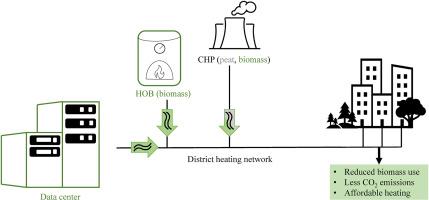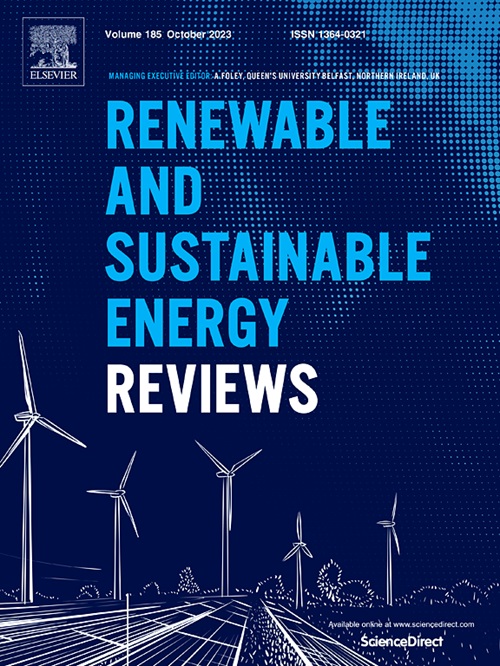Reducing district heating carbon dioxide emissions with data center waste heat – Region perspective
IF 16.3
1区 工程技术
Q1 ENERGY & FUELS
引用次数: 0
Abstract
Climate targets require district heating companies to decarbonize heat production as well as data centers to improve their energy efficiency and waste heat utilization. This study includes an energyPRO software modeling of a district heating network with a planned 21 MW data center in the Ostrobothnia region in Finland to investigate the effect of data center waste heat in a district heating network. Five future scenarios with assumptions on electricity, fuel and carbon dioxide prices were modeled to analyze the reduction of district heating carbon dioxide emissions with data center waste heat and related cost savings. The results indicate that carbon dioxide emissions decrease cost-effectively as waste heat replaces the use of high-emission peat. In scenarios with higher biomass prices, the emissions and costs decrease the most with waste heat utilization. Interviews conducted with stakeholders highlight that district heating companies should not be dependent only on one data center due to the volatile nature of the industry and the heat production costs. They also underlined that the data center is expected to improve local economic activity and the international network of the region. The interviews also indicate that broad local support for the data center can be achieved due to the emission reductions and positive impacts on local employment and the economy. The use of local peat fuel was widely understood to be phased out due to climate policy.

利用数据中心余热减少区域供热二氧化碳排放--地区视角
气候目标要求区域供热公司实现热能生产的去碳化,并要求数据中心提高能源效率和余热利用率。本研究使用 energyPRO 软件对芬兰 Ostrobothnia 地区的一个区域供热网络进行建模,该区域计划建设一个 21 兆瓦的数据中心,研究数据中心废热对区域供热网络的影响。根据对电力、燃料和二氧化碳价格的假设,对五种未来情景进行了建模,以分析利用数据中心余热减少区域供热二氧化碳排放量及相关成本节约的情况。结果表明,随着废热取代高排放泥炭的使用,二氧化碳排放量的减少具有成本效益。在生物质价格较高的情况下,利用余热减少的排放量和成本最多。与利益相关者进行的访谈强调,由于行业和制热成本的不稳定性,区域供热公司不应只依赖于一个数据中心。他们还强调,数据中心有望改善当地的经济活动和该地区的国际网络。访谈还表明,由于数据中心可实现减排并对当地就业和经济产生积极影响,因此可获得当地的广泛支持。人们普遍认为,由于气候政策,当地泥炭燃料的使用将被逐步淘汰。
本文章由计算机程序翻译,如有差异,请以英文原文为准。
求助全文
约1分钟内获得全文
求助全文
来源期刊

Renewable and Sustainable Energy Reviews
工程技术-能源与燃料
CiteScore
31.20
自引率
5.70%
发文量
1055
审稿时长
62 days
期刊介绍:
The mission of Renewable and Sustainable Energy Reviews is to disseminate the most compelling and pertinent critical insights in renewable and sustainable energy, fostering collaboration among the research community, private sector, and policy and decision makers. The journal aims to exchange challenges, solutions, innovative concepts, and technologies, contributing to sustainable development, the transition to a low-carbon future, and the attainment of emissions targets outlined by the United Nations Framework Convention on Climate Change.
Renewable and Sustainable Energy Reviews publishes a diverse range of content, including review papers, original research, case studies, and analyses of new technologies, all featuring a substantial review component such as critique, comparison, or analysis. Introducing a distinctive paper type, Expert Insights, the journal presents commissioned mini-reviews authored by field leaders, addressing topics of significant interest. Case studies undergo consideration only if they showcase the work's applicability to other regions or contribute valuable insights to the broader field of renewable and sustainable energy. Notably, a bibliographic or literature review lacking critical analysis is deemed unsuitable for publication.
 求助内容:
求助内容: 应助结果提醒方式:
应助结果提醒方式:


